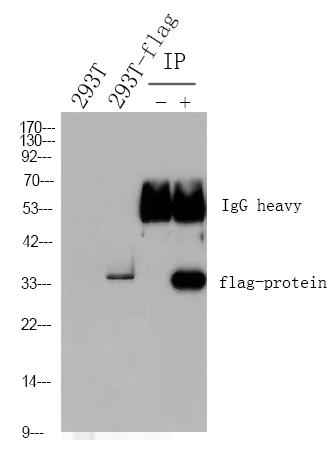
Catalog: YA0407
Size
Price
Status
Qty.
200μg
$600.00
3 weeks
0
100μg
$340.00
3 weeks
0
40μg
$190.00
3 weeks
0
Add to cart


Collected


Collect
Main Information
Target
TNFa
Reactivity
Human
Applications
ELISA
Conjugate/Modification
Unmodified
Detailed Information
Recommended Dilution Ratio
ELISA 1:5000-100000; Flow Cyt 1-2μg/Test
Formulation
Phosphate-buffered solution
Source
Camel, chimeric fusion of Nanobody (VHH) and mouse IgG1 Fc domain , recombinantly produced from 293F cell
Specificity
This recombinant monoclonal antibody can detects endogenous levels of TNFa protein.
Purification
Recombinant Expression and Affinity purified
Storage
-15°C to -25°C/1 year(Avoid freeze / thaw cycles)
Concentration
Please check the information on the tube
Modification
Unmodified
Clone Number
PN0361
Related Products
Antigen&Target Information
Immunogen:
Purified recombinant Human TNFa
show all
Specificity:
This recombinant monoclonal antibody can detects endogenous levels of TNFa protein.
show all
Gene Name:
TNF TNFA TNFSF2
show all
Protein Name:
Tumor necrosis factor (Cachectin) (TNF-alpha) (Tumor necrosis factor ligand superfamily member 2) (TNF-a) [Cleaved into: Tumor necrosis factor, membrane form (N-terminal fragment) (NTF); Intracellular domain 1 (ICD1); Intracellular domain 2 (ICD2); C-doma
show all
Other Name:
TNF ;
TNFA ;
TNFSF2 ;
Tumor necrosis factor ;
Cachectin ;
TNF-alpha ;
Tumor necrosis factor ligand superfamily member 2 ;
TNF-a ;
TNFa nanobody ;
TNFA ;
TNFSF2 ;
Tumor necrosis factor ;
Cachectin ;
TNF-alpha ;
Tumor necrosis factor ligand superfamily member 2 ;
TNF-a ;
TNFa nanobody ;
show all
Background:
This gene encodes a multifunctional proinflammatory cytokine that belongs to the tumor necrosis factor (TNF) superfamily. This cytokine is mainly secreted by macrophages. It can bind to, and thus functions through its receptors TNFRSF1A/TNFR1 and TNFRSF1B/TNFBR. This cytokine is involved in the regulation of a wide spectrum of biological processes including cell proliferation, differentiation, apoptosis, lipid metabolism, and coagulation. This cytokine has been implicated in a variety of diseases, including autoimmune diseases, insulin resistance, and cancer. Knockout studies in mice also suggested the neuroprotective function of this cytokine. [provided by RefSeq, Jul 2008],
show all
Function:
Disease:Cachexia accompanies a variety of diseases, including cancer and infection, and is characterized by general ill health and malnutrition.,Disease:Genetic variations in TNF are associated with susceptibility to hepatitis B virus infection (HBV infection) [MIM:610424]. Approximately one third of all cases of cirrhosis and half of all cases of hepatocellular carcinoma can be attributed to chronic HBV infection. HBV infection may result in subclinical or asymptomatic infection, acute self-limited hepatitis, or fulminant hepatitis requiring liver transplantation.,Disease:Genetic variations in TNF are associated with susceptibility to psoriatic arthritis [MIM:607507]. Psoriasis is a chronic inflammatory dermatosis that affects approximately 2% of the population. It is characterized by red, scaly skin lesions that are usually found on the scalp, elbows, and knees, and may be associated with severe arthritis. Psoriatic arthritis has been defined as an inflammatory arthritis usually without any rheumatoid factor in serum (seronegative arthritis) associated with psoriasis.,Function:Cytokine that binds to TNFRSF1A/TNFR1 and TNFRSF1B/TNFBR. It is mainly secreted by macrophages and can induce cell death of certain tumor cell lines. It is potent pyrogen causing fever by direct action or by stimulation of interleukin-1 secretion and is implicated in the induction of cachexia, Under certain conditions it can stimulate cell proliferation and induce cell differentiation.,online information:The Singapore human mutation and polymorphism database,online information:Tumor necrosis factor alpha entry,PTM:O-glycosylated; glycans contain galactose, N-acetylgalactosamine and N-acetylneuraminic acid.,PTM:The membrane form, but not the soluble form, is phosphorylated on serine residues. Dephosphorylation of the membrane form occurs by binding to soluble TNFRSF1A/TNFR1.,PTM:The soluble form derives from the membrane form by proteolytic processing.,similarity:Belongs to the tumor necrosis factor family.,subunit:Homotrimer.,
show all
Cellular Localization:
Cell membrane ; Single-pass type II membrane protein .; [Tumor necrosis factor, membrane form]: Membrane; Single-pass type II membrane protein.; [Tumor necrosis factor, soluble form]: Secreted .; [C-domain 1]: Secreted.; [C-domain 2]: Secreted.
show all
Tissue Expression:
Expressed on the plasma membranes of all cell types that are in intimate contact with plasma complement proteins. It is also found on the surfaces of epithelial cells lining extracellular compartments, and variants of the molecule are present in body fluids and in extracellular matrix.
show all
Signaling Pathway
Reference Citation({{totalcount}})
Catalog: YA0407
Size
Price
Status
Qty.
200μg
$600.00
3 weeks
0
100μg
$340.00
3 weeks
0
40μg
$190.00
3 weeks
0
Add to cart


Collected


Collect
Recently Viewed Products
Clear allPRODUCTS
CUSTOMIZED
ABOUT US
Toggle night Mode
{{pinfoXq.title || ''}}
Catalog: {{pinfoXq.catalog || ''}}
Filter:
All
{{item.name}}
{{pinfo.title}}
-{{pinfo.catalog}}
Main Information
Target
{{pinfo.target}}
Reactivity
{{pinfo.react}}
Applications
{{pinfo.applicat}}
Conjugate/Modification
{{pinfo.coupling}}/{{pinfo.modific}}
MW (kDa)
{{pinfo.mwcalc}}
Host Species
{{pinfo.hostspec}}
Isotype
{{pinfo.isotype}}
Product {{index}}/{{pcount}}
Prev
Next
{{pvTitle}}
Scroll wheel zooms the picture
{{pvDescr}}
















